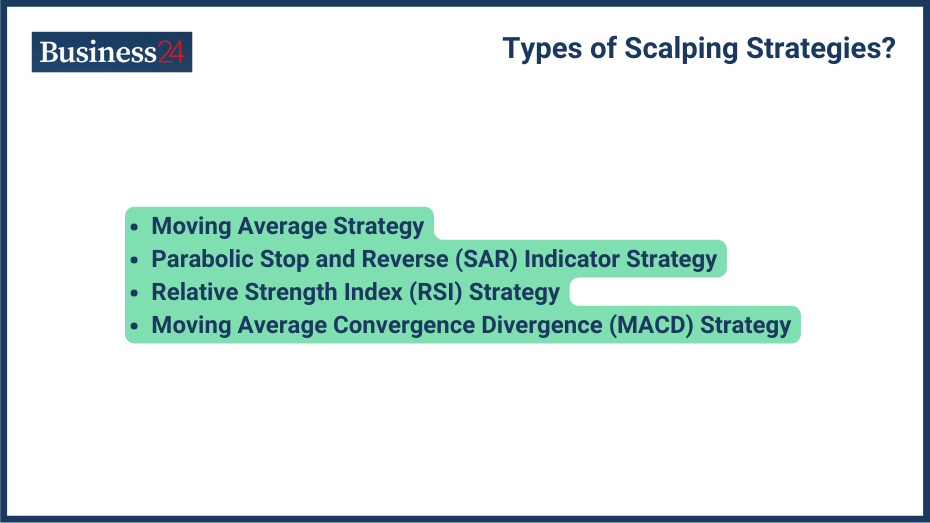
Scalping is a very short trading strategy involving holding positions for a very brief period, seconds to minutes. Traders who trade this strategy are called scalpers; they look to make quick profits by taking advantage of small price changes within the same trading day.
Fast execution and capturing small movements are very important for scalping. Unlike other trading strategies where positions might be held for several hours, scalping involves entering and exiting trades within seconds or minutes. Scalpers profit by taking many small trades, relying on swift decision-making, and analyzing real-time market data.
What are the Types of Scalping Strategies?

Scalpers have different strategies for different market conditions:
- Moving Average Strategy: This approach uses simple or exponential moving averages to identify the average price over a chosen period. Price characteristic is to fall back to their moving averages; scalpers use this method to execute the trade in real time.
- Parabolic Stop and Reverse (SAR) Indicator Strategy: Employs the Parabolic SAR indicator to identify potential reversal points in price, aiding in risk management by setting strategic stop-loss orders.
- Relative Strength Index (RSI) Strategy: The RSI tells the overbought and oversold in the price by measuring the momentum and speed of price movements. Scalpers use RSI signals to identify entry and exit points for trades.
- Moving Average Convergence Divergence (MACD) Strategy: The MACD combines and analyzes the relationship between two moving averages to interpret changes in momentum and potential future price trends. By reading MACD signals, scalpers can aim to capitalize on those trends.
What are the Benefits and Risks of Scalping?

Benefits:
- Small, Consistent Gains: Scalpers capitalize on small repetitive gains; this way, they compound the gains over time.
- Limited Exposure: Traders don’t stay on the trade for longer than minutes; this quick entry and exit nature minimizes a trader’s exposure to negative market movements, potentially reducing overall risk.
- Rule-Based System: Scalping involves following specific trading rules, which can improve discipline and even allow some trading parts to be automated.
Risks:
- High Costs: Taking more traders directly implies higher fees; this frequent fee can add to a huge amount over time.
- Time-Consuming: Scalping trading is not a part time job; it requires constant monitoring of markets and quick decision-making, making it a very demanding trading style.
- Potential for Losses: Without experience and tested strategy, scalping can easily destroy the capital with many cuts.
What is Risk Management in Scalping?
Effective risk management is important for any trading strategy, including scalping; it is the foundation of any trader. Here are some essential practices you can apply to your risk management:
- Set Stop-Loss Orders: Not only scalping but any trading strategy requires setting a stop loss, as it limits loss.
- Utilize Technical Indicators: Tools like moving averages and RSI can provide valuable insights for making informed trading decisions.
- Maintain Discipline: Sticking to your trading plan and avoiding impulsive trades is crucial for long-term success.
Is scalping good for beginners?
The direct answer to this question is no. Scalping is not recommended for beginners because it’s quite demanding in terms of time, resources, and experience. The fast-paced setting requires continuous attention and quick decisions, which can overwhelm new traders.
You can start by trading every day and gain some experience. With time, you can decrease the timeframe from daily to hourly to minute and become a scalper.
What are the Practical Applications and Strategies for Scalping?
Scalping can be implemented in two primary ways:
- Primary Style: For some traders, scalping is their main trading strategy; they solely focus on scalping and make a living from it. They dedicate their trading day to making many trades on the frequent price movement.
- Supplementary Style: Other traders might use scalping as a complementary strategy, particularly in volatile or range-bound markets where short-term trends offer the potential for quick profits.
What Is Considered Scalping?
Any trade that is being held for seconds to minutes is considered scalping. By definition, Scalping is a trading strategy where traders hold their positions for a very short period, sometimes just minutes or seconds, to make quick profits. Scalpers must stay highly alert and make decisions rapidly as market conditions change.
For example, consider trading TESLA stock, fluctuating around $170 and $172. A scalper might notice this pattern and predict the price will stay within this range a bit longer. They might buy 100 shares at $170, predicting the price will rise slightly. If the price increases to $171, the scalper quickly sells the shares to earn a profit of $1 per share, totaling $100 (100 shares x $1). Scalpers do this repeatedly throughout the day, aiming to collect small gains from these minor price movements.
Is scalp trading illegal?
No, scalp trading is not illegal. Scalping itself is a legitimate trading strategy. However, some manipulative trading practices involving rapid buying and selling can be illegal. Legitimate scalpers are like speedy shoppers who take the deal quickly and benefit from it.
However, problems occur when scalping is used to manipulate the market. This might include tactics like spoofing, where traders place orders only to cancel them, creating a false impression of demand, or wash trading, where they quickly buy and sell the same asset to mislead others about the market activity.
What are Some Educational Resources and Tools for Scalping?
Books and Articles: Scalping has been here for a long time, so there are many books and articles that can teach the basics of scalping. Here is a out top pick.
Online Courses: Nowadays, new traders look for quick money, so scalping has been very popular recently, and due to the demand, there are hundreds of courses available. While not all the courses are good with research, you can find some good ones. Check out some Udemy courses.
Trading Simulators: These tools allow you to practice scalping strategies without risking real money, offering a safe space to hone your skills. TrendSpider has some options.
Disclaimer
eToro is a multi-asset platform which offers both investing in stocks and cryptoassets, as well as trading CFDs.
Please note that CFDs are complex instruments and come with a high risk of losing money rapidly due to leverage. 51% of retail investor accounts lose money when trading CFDs with this provider. You should consider whether you understand how CFDs work, and whether you can afford to take the high risk of losing your money
This communication is intended for information and educational purposes only and should not be considered investment advice or investment recommendation. Past performance is not an indication of future results.
Copy Trading does not amount to investment advice. The value of your investments may go up or down. Your capital is at risk.
Don’t invest unless you’re prepared to lose all the money you invest. This is a high-risk investment and you should not expect to be protected if something goes wrong. Take 2 mins to learn more
eToro USA LLC does not offer CFDs and makes no representation and assumes no liability as to the accuracy or completeness of the content of this publication, which has been prepared by our partner utilizing publicly available non-entity specific information about eToro.
